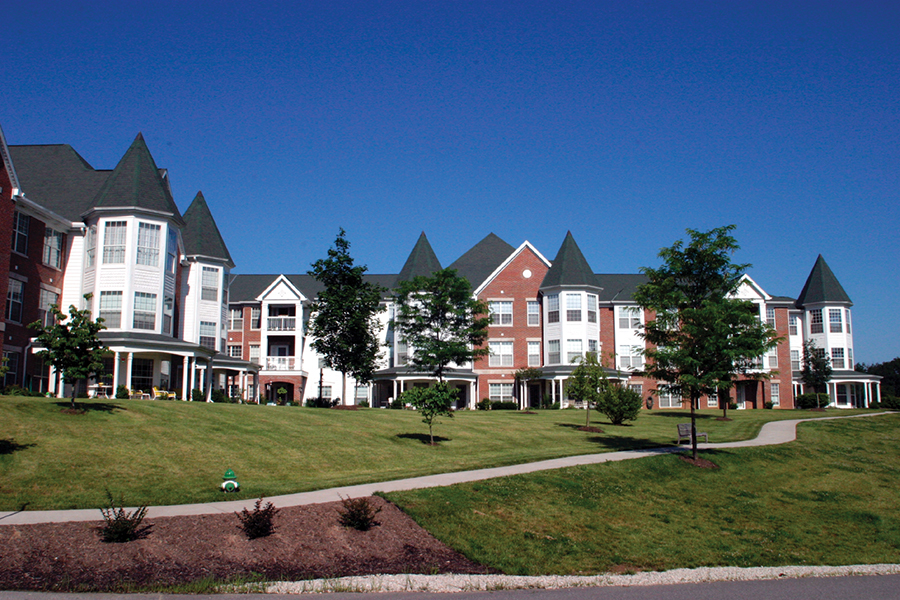The Woodlands Retirement Community offers its residents accommodations fit for a king.
By Kimberly Carico Simpson
HQ 48 | SUMMER 2003
When young children go to visit their grandparents who live in the Woodlands Retirement Community, some call the stately structure “the castle on the hill.” That castle on the hill is quite possibly one of Huntington’s greatest success stories.
Woodlands marked its seventh anniversary in August. It’s a retirement community that meets virtually every need of its residents and offers a variety of living accommodations from cottages and suites for independent living to private rooms for assisted living or nursing care.
One of the most remarkable things about Woodlands Retirement Community is the story behind it. Woodlands is not a member of a healthcare conglomerate. It is not owned or operated by a national medical corporation. Rather, it is owned by the Foster Foundation, a non-profit organization established in Huntington in 1922.

Bradley W. Foster, a native of Maine, married the niece of Collis P. Huntington in 1868. Foster and Mary Lenora Huntington settled in Guyandotte in 1871 and purchased many pieces of land along the Ohio River. The Fosters then moved to Huntington just after the first lots in the city became available for sale. While making the sum of his wealth through real estate and hardware, Foster also was a member of city council and served in many community leadership capacities. While the Foster family history is extensive, it is also tangible as seen today in Woodlands Retirement Community.

Upon his death in 1922, having been preceded in death by his wife and having no children, B.W. Foster established in his will the Foster Foundation,appointing many close friends to the foundation’s board of directors.
“The foundation was created to engage in charitable acts,” said Gray Hampton, Presbyterian minister and two-year resident of Woodlands. “(Foster) left $800,000 to the foundation. Foster Memorial Home (on Madison Avenue) was created in 1925 as a place for aging women.”

While many people have served on the board of the Foster Foundation, Hampton, a Huntington native and former board member himself, used his time on the board in the early 1980s to help facilitate talks of what would become Woodlands. Today, a seven-member panel of volunteers runs the foundation.

“The foundation continued to run,” Hampton said. “The board changed. Over time, we began to talk about the foundation’s resources and a retirement home. About three years before we broke ground on Woodlands, large groups of seniors in the Huntington area began meeting and planning.” Hampton used his connection with downtown ministers to pool together as many as 120 people to use as a resource for ideas in the planning the community.

“We discussed the possibility of having a gate and a gatekeeper,” Hampton said. “We discussed meals. We decided that if you come to meals, you sit and talk with others, and so now meals are included in the cost of living at Woodlands. The groups continued to meet. We found a site and put out bids. The group even had input into the design.”

Perhaps the group and the architects, JMM Architects of Columbus, Ohio, did not intend to create a castle, but one look at Woodlands explains why visiting grandchildren are likely to envision a storybook setting.
Located just off the 5th Street exit of Interstate 64 and overlooking West Virginia’s green hilltops, Woodlands covers 170 acres of land. The facility itself includes 300,000 square feet of space, and the buildings are valued at more than $30 million. A staff of 110 employees cares for the residents and maintains the grounds.
The Foster Foundation invested $5 million for the first phase of the project, while $16 million was financed through Huntington Banks. There is no government funding in Woodlands, according to Woodlands Executive Director and CEO Donald J. Faherty. Even the retirement community’s streets and sewers were built through foundation funding, Faherty said proudly.

The 285 residents who call Woodlands home can enjoy three ponds, a walking trail, three impeccably-decorated vaulted-ceiling dining rooms, many fireplaces throughout the facility and 15 parlors with furnishings by Lodging Interiors of Atlanta, which is known for its decoration of fine hotels.
For some residents, the location of Woodlands is equally as important as the amenities.

“Today, many of our residents would be somewhere else if Woodlands weren’t here,” Faherty said. “This retirement community has kept these people in town. Many residents said they wanted to stay near their families. Huntington has benefited from Woodlands, as well. Many of our residents have children living here in town.”
Faherty is familiar with the stories and backgrounds of all the residents. He met them while showing each and every suite to interested residents. While walking throughout Woodlands during his daily routine, Faherty calls residents by name and takes time to say hello. Faherty came to Woodlands even before construction began and has had a hand in its’ success from the onset.
In addition to serving local retirees, Woodlands has residents from eight states. There are 375 more people on a waiting list.

“We don’t advertise,” Faherty said. “We don’t do marketing. People know about us from their family and friends.” Professionals in the retirement living industry from around the country come to tour the unique community.
Because of its success, Woodlands continues to grow. With a $2 million donation from the Episcopal Church and James and Joan C. Edwards, known for their many donations to the Huntington community, Woodlands is expanding its healthcare facility.
“We’re adding a sixth wing (to be named The Edwards/Episcopal Wing) for additional health care,” Faherty said. “Once it’s finished, we’ll have about 90 beds for residents who need personal and nursing care. We staff our personal care facility at a higher level than most nursing homes.” There are three floors with nurses’ stations and hospital beds, and the staff consists of registered nurses (RNs), licensed practical nurses (LPNs) and certified nurses’ aides (CNAs).

Some residents make the gradual transition from independent living to assisted living (personal care) or nursing care depending on their needs.
Regardless of the living quarters, residents bring with them their own furnishings, which helps their Woodlands home feel more like their former homes.
Gerry Huff, RN, is the director of nursing who oversees 16 nurses and 38 CNAs at Woodlands. She said the staff helps residents feel at home, too.
“Some of the staff have known the residents since Woodlands opened almost seven years ago,” Huff said. “For some, we are their family. It’s an important feature here. We’re very family oriented.”
There are many facilities and services at Woodlands to help residents feel not only at home but also like a member of a community. Each resident has a conveniently-located private mailbox. Each living space has a separate storage area for Christmas decorations and luggage. There is an on-site hair and nail salon, a card shop and a country store that sells single sticks of margarine and eggs one at a time.
Daily activities are posted throughout the community and on any day could include Bible study, Tai Chi or light aerobic exercise with a recreational therapist, a billiards tournament, table tennis, an ice cream social or a bus trip to the Huntington Mall.
Of course, despite the attempt to make each resident feel like part of the Woodlands family, there are always complaints, as Hampton pointed out. “The food is too good, and everybody gains weight,” he said, smiling.
For more background information on Woodlands Retirement Community visit www.woodlandswv.com.





